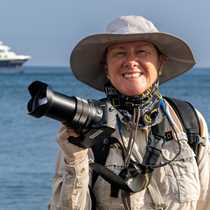Pacaya River & Carocurahuite Lagoon
Merry Christmas everyone! It all began with a knock on the door…at 0600…be ready in half-an-hour! Forewarned the night before, everyone knew that something special would happen on this morning’s excursion; it was to be just a little bit different…
We were off! Skiffs loaded, we buzzed across the “Canal de Puinahua” which is actually a branch of the Ucayali River. One has to look carefully at the map to realize that the Ucayali River branches into two strong arms that reunite 100 kilometers downriver, leaving a large, very large, island in between. In the past, the southern route has been the favored waterway for traffic coming down from Pucalpa, a major economic hub for the NW Peruvian Amazon region, and therefore kept the name of the river “Ucayali”. Lately though, the flow has been increasing along the northern route, named the “Canal de Puinahua” and more river traffic is starting to choose this route to descend the river instead. It is possible that in the not-so-far-future, villages and towns on the southern route will find themselves on the edge of an oxbow lake instead of a major water thoroughfare. The silting up of rivers is happening all the time, and has for eons, and will continue for millennia.
At the mouth of the Pacaya River, pink dolphins and gray river dolphins were seemingly frolicking about, teasing us into snapping away with our cameras. I have a standing offer out there for anyone who gets a good, focused photo of a pink dolphin in the same frame as a skiff – a free drink on me! I have yet to pay and time is running out.
The morning trip up the river was dramatically different from yesterday in terms of wildlife activity. The number of great egrets, snowy egrets and Neotropical cormorants was mind-blowing…in the thousands they lined the waterway for the first half of our journey. The horned screamers had all the tall trees staked out, a territory every hundred yards or so. Howler monkeys, squirrel monkeys, sloths, brown capuchin monkeys – they were all there.
The delightful addition to our trip was breakfast served on the skiffs! That explained the extra crew members who had come along for the ride…all put on their white gloves and as we sat in the shade, tied up under a beautiful fig tree, we munched away, drinking our tropical juices, tea or coffee. A pit stop on land and we were off again for a short while longer – and oh my, was it worth it! Red-and-green macaws! I don’t believe I had ever seen them in the wild before, so that was a top thrill for me. Hoatzins, those so-bizarre-birds were hiding in the water philodendrons nearby, and howler monkeys roared in distance.
The afternoon had a different treat in store for us. We visited a site down river called “Carocurahuite.” “Caro” means expensive; “cura” refers to healing, and “huite” is a proper noun. It all relates to an expensive “curandero” or healer named “Huite”. Carocurahuite. We went fishing there, and quite a few caught piranhas! A few even big enough to eat, although we practice catch and release on principle. The rest went on a productive skiff ride down the Carocurahuite River where squirrel monkeys and countless birds caught our eyes and lenses. But there is a Christmas story here I would like to tell you as well. A few bends past the entrance of the river is a village. As we passed the first few houses, our wake gently rocking the local dugouts tied on shore, children and adults came to stand on shore to wave. It is only within the last few days that the river level has risen enough to make the stream navigable. It's probably been months since they've seen anyone other than their own canoes in the area.
When the first skiff cruised past the main grouping of thatched huts, several women were lined up on shore waving the skiff over with concern on their faces. They had a medical situation and asked if our doctor could possibly help. The Delfin II always travels with a paramedic on board, a man of considerable experience in jungle medicine, both military and with petroleum exploration teams. Segundo, the paramedic, was in the second skiff to come by, and with no hesitation jumped on shore with his ever-present medical backpack and stayed in the village while the rest of us continued with our program, wondering what the emergency could be. It turned out that a young man of 20 had been bitten the previous day by a fer-de-lance, one of the deadliest vipers found in the Amazon region. We learned then, that Segundo always travels with more than just the basic bandages and creams, but with anti-snakebite serum as well.
The most important part of this story was the end: the young man would be fine. Our prepared paramedic, the presence of the Delfin II at the village, saved a life today, Christmas.




